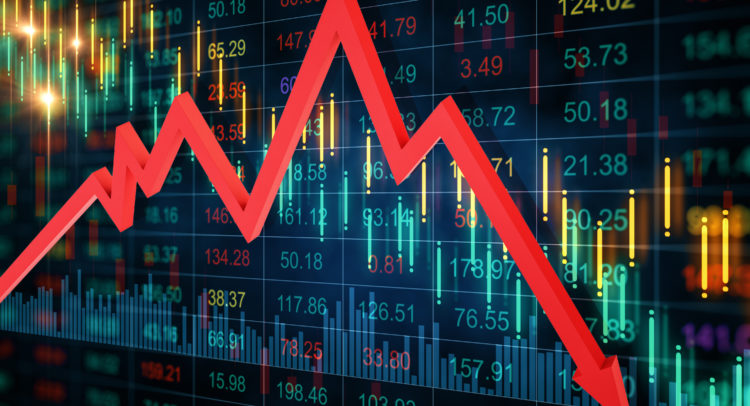Stocks Finish Monday’s Session in Negative Territory
Last Updated 4:20 PM EST
Stock indices finished today’s trading session in the red. The Dow Jones Industrial Average, the S&P 500, and the Nasdaq 100 decreased 1.91%, 2.14%, and 2.66%, respectively.
The communications sector was today’s laggard, as it lost 2.86%. Conversely, the energy sector was the session’s leader, but it still declined by 0.19%. In addition, WTI crude oil gained 0.61%, reaching $90.42 per barrel.
Furthermore, the U.S. 10-Year Treasury yield increased to 3.03%, a gain of 5.4 basis points. Similarly, the Two-Year Treasury yield also jumped, as it hovers around 3.33%. This brings the spread between them to -30 basis points. The negative spread indicates that investors still have fears of a recession.
Compared to Friday, the market is pricing in a higher chance of a higher Fed Funds rate for the end of the year. In fact, the market’s expectations for a rate in the range of 3.75% to 4% increased to 29.1%, which is up from Friday’s expectations of 19.4%. In addition, the market is now also assigning a 21.7% probability to a range of 3.25% to 3.5%. For reference, investors had assigned a 30.6% chance Friday.
Gas Prices Continue to Decline
Last Updated 3:00PM EST
Equity markets are in the red heading into the final hour of today’s trading session. As of 3:00 p.m. EST, the Dow Jones Industrial Average, the S&P 500, and the Nasdaq 100 are down 2%, 2.2%, and 2.7%, respectively.
The communications sector is the laggard so far, as it is down 2.9%. Conversely, the energy sector is the session’s leader. Nevertheless, it is still down 0.5%.
WTI crude oil is currently hovering around $90 per barrel, as it trades not too far away from its session high of $91.03 per barrel. The commodity has made a significant comeback in today’s session after previously falling to $86.29 per barrel.
Fortunately, oil’s overall downtrend has led to lower gas prices across the country. The national average for regular gas was last $3.901 per gallon, down from yesterday’s reading of $3.904. This is significantly lower than the all-time high of $5.016 per gallon on June 14.
The highest price can be found in California, where prices are substantially higher than the national average, at $5.324 per gallon. On the other hand, Arkansas is the state with the lowest gas price, at $3.406 per gallon.
It’s likely that this downward trend will continue going forward as the Federal Reserve looks to raise interest rates to fight inflation. However, higher rates will destroy demand throughout the whole economy. As a result, lower gas prices might have to come at the cost of a recession.
Ford Announces It Will Layoff 3,000 Workers
Last Updated 12:00PM EST
Stock indices are in the red halfway into today’s trading session. As of 12:00 p.m. EST, the Dow Jones Industrial Average, the S&P 500, and the Nasdaq 100 are down 1.4%, 1.6%, and 2.1%, respectively.
The communications sector (XLC) is the laggard so far, as it is down 2.1%. Conversely, the energy sector has made a comeback to become the session’s leader. Nevertheless, it is still down 0.3%.
Monday has not been a good day for Ford (F) investors. The stock is down 5% after a court ruling ordered Ford to pay a hefty fine. In addition, the company announced that it will be laying off 3,000 workers. The employees being let go will consist of salary and contract workers. Ford is the latest addition to the growing list of large companies that have been reducing their workforce in order to save costs amid a slowing economy.
Meanwhile, bond yields are higher, as the U.S. 10-Year Treasury yield is now hovering around 3.03%. This represents an increase of 5.4 basis points from the previous close.
Similar movements can be seen with the Two-Year yield, which is now at 3.33%. However, the spread between the 10-Year and Two-Year U.S. Treasury yields is still negative, sitting at -30 basis points.
Stocks are in the Red to Start Monday’s Trading Session
Last Updated 10:00AM EST
Stock indices are in the red 30 minutes into today’s trading session. As of 10:00 a.m. EST, the Dow Jones Industrial Average, the S&P 500, and the Nasdaq 100 are down 1.2%, 1.4%, and 1.7%, respectively.
The energy sector (XLE) is the laggard so far, as it is down 2.1%. Conversely, the consumer staples sector (XLP) is the session’s leader, with a gain of 2.9%.
WTI crude oil fell below $90 per barrel as investors worry that an economic slowdown will impact demand for oil. As a result, the price is hovering around the high-$86 per barrel range, which equates to a decline of more than 3% from the previous close.
Meanwhile, bond yields are higher, as the U.S. 10-Year Treasury yield is now hovering around 2.99%. This represents an increase of 1.4 basis points from the previous close.
Similar movements can be seen with the Two-Year yield, which is now at 3.31%. However, the spread between the 10-Year and Two-Year U.S. Treasury yields is still negative, currently sitting at -32 basis points.
Pre-Market Update
U.S. stock futures dipped early Monday morning amid renewed fears of another aggressive interest rate hike.
Futures on the Dow Jones Industrial Average (DJIA) inched 0.46% lower, while those on the S&P 500 (SPX) lost 0.58%, as of 2.59 a.m. EST, Monday. Meanwhile, the Nasdaq 100 (NDX) futures dipped 0.79%.
At the end of Friday’s regular trading session, the S&P 500 closed 1.29% lower, the Dow slipped 0.86%, and the Nasdaq 100 dropped 1.95%.
Fed Firmly Hawkish
The Federal Reserve is most likely to increase interest rates by another 75 basis points in its September meeting. Last week, Federal Reserve Bank of St. Louis President, James Bullard, commented that he is supportive of a large interest rate hike next month, adding that he is not fully convinced that the worst of the inflation is over.
Moreover, on Friday, Fed Chair Jerome Powell hinted at a significant rate lift intended for September, which will be held at the Jackson Hole economic symposium. Stressing the need to bring down inflation on an immediate basis, Powell explained that reaching an inflation range of 2.25%-2.5% as soon as possible is critical to achieving optimal and sustainable employment. The Fed is ready to risk a recession in order to reach its target inflation rate.
China Cuts Rates Again
Meanwhile, the People’s Bank of China reduced its interest rates again, a week after its surprise rate cut. The one-year and five-year benchmark lending rates were trimmed by 5 basis points and 15 basis points, respectively.
This strategic move was made in a further attempt to stabilize a contracting economy by boosting demand. Inflation, stringent trade policies, and the recent bout of Covid-related lockdowns have hurt the economy worse than expected. However, some leading experts are of the opinion that the current interest rate cuts are still not enough to bring back consumers to their previous level of spending, and the economy needs a stronger stimulus to rise again.
This is worrisome for the U.S. economy, as it might be staring at its own future. While the second largest economy in the world is struggling to revive its economy after a severe economic slowdown, the central bank of the world’s largest economy is considering a step that could increase the risk of recession, in order to bring down inflation.


















